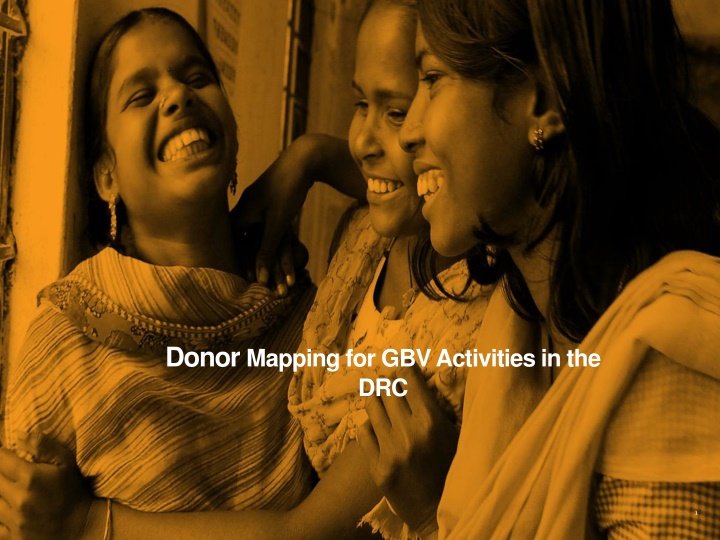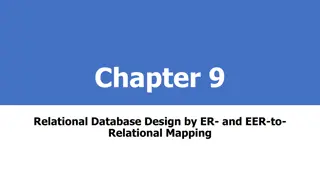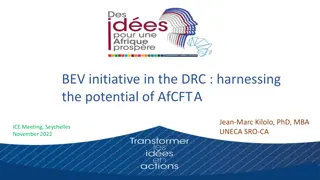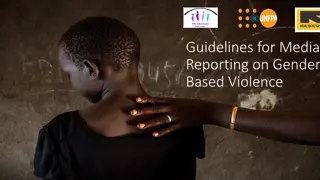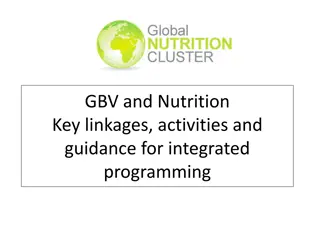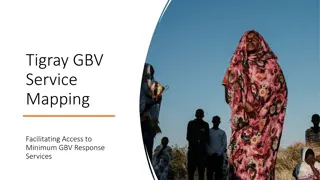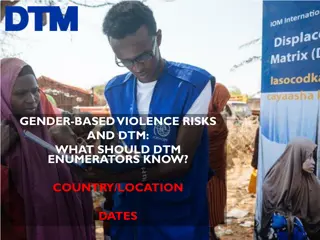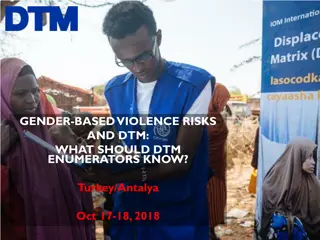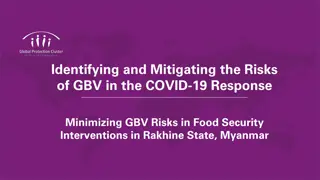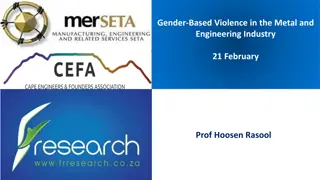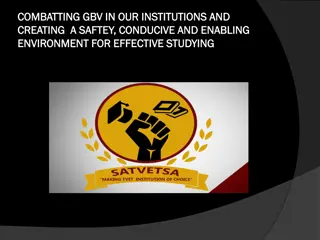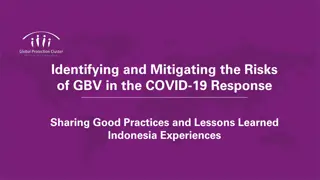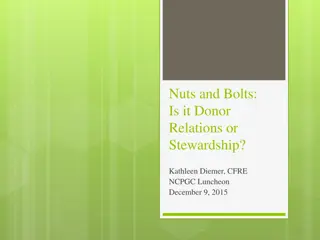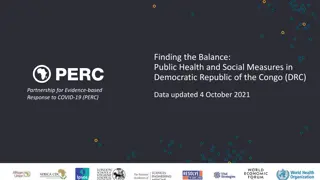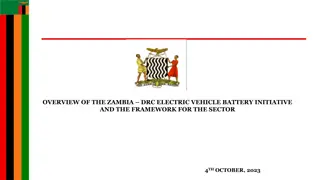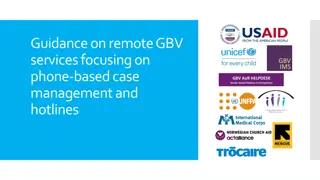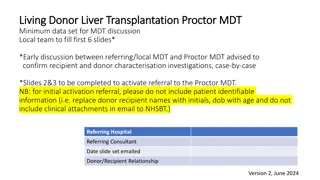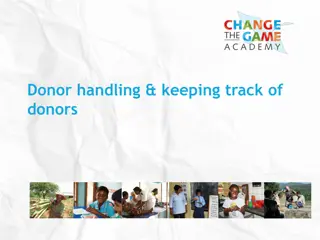Donor Mapping for GBV Activities in the DRC
This report delves into the magnitude and severity of gender-based violence (GBV) in the Democratic Republic of the Congo (DRC) in recent years. It highlights the methodology used in data collection, key results, and leveraging findings for advocacy. The report also outlines the objectives of the mapping exercise including identifying humanitarian hubs, donors funding GBV activities, funding gaps, and advocating for increased funding. Detailed data collection methodologies are discussed along with mapping severity levels across different provinces in the DRC.
Download Presentation

Please find below an Image/Link to download the presentation.
The content on the website is provided AS IS for your information and personal use only. It may not be sold, licensed, or shared on other websites without obtaining consent from the author.If you encounter any issues during the download, it is possible that the publisher has removed the file from their server.
You are allowed to download the files provided on this website for personal or commercial use, subject to the condition that they are used lawfully. All files are the property of their respective owners.
The content on the website is provided AS IS for your information and personal use only. It may not be sold, licensed, or shared on other websites without obtaining consent from the author.
E N D
Presentation Transcript
Sous-Cluster VBG Plan 1. Context: Magnitude of GBV in DRC in 2020 2. Context: Severity of GBV in DRC 2021 3. Methodology used to collect data on donor mapping 4. Key results 5. Leveraging findings for advocacy
Sous-Cluster VBG 1. Magnitude of GBV in 2020 in the DRC Context Magnitude of VBG Armed conflicts in Ituri, North Kivu, South Kivu Inter-community conflicts in Tanganyika, South Kivu and Maniema, Ituri Cyclical movement of populations: displaced & return Land and customary related conflicts in the Kasai region Urban insecurity and COVID-19 impacts
Sous-Cluster VBG 2. Mapping of severity of GBV in DRC 7 provinces have a catastrophic severity level 13 out of 26 provinces have a critical severity score 6 provinces have a severe level The severity score is obtained by combining population movement and food insecurity
Sous-Cluster VBG 3. Objectives of the mapping Identify humanitarian hubs where GBV prevention and response projects are funded Identify donors who fund GBV prevention and response activities Identify funding gaps based on the duration of current funding Understand the nature of donors and the responses funded (humanitarian versus development) Advocate with the donor community in the DRC on the funding gaps for GBV interventions
Sous-Cluster VBG 4. Data collection methodology(i) Development of information needs by the Coordination after consultation with the GBV Sub-Cluster Development and validation of indicators depending on the information need Development of an excel data collection matrix by the GBV Sub-Cluster IM Team Data collection for 10 days with members of the Sub- Cluster
Sous-Cluster VBG 4. Data collection methodology (ii) Information processing by the IM team in collaboration with regional GBV SC coordinators Review and validation of data by the IM team Production of a mapping by the IM team Data analysis and development of a narrative by the coordination.
Sous-Cluster VBG 5. List of indicators Explanation It indicates the humanitarian hubs with funding on the 4 regional humanitarian hubs in the DRC Indicators Geographic Coverage Contents Number of humanitarian hubs funded by a project Number of projects disaggregated by type: humanitarian and development Funding type It indicates the funding dedicated for the response to GBV in humanitarian emergencies versus the response to GBV in development situations.
Sous-Cluster VBG 5. List of indicators (ii) Contents Number of funded partners disaggregated by type: UN, international NGO, national NGO, Women's organizations Explanation It indicates the number of projects by type of recipient. It makes it possible to analyse whether location issues are taken into account when granting funds to members of the Sub-Cluster It indicates the duration of projects and makes it possible to identify the gaps in terms of project duration by humanitarian hubs Indicators Type of organization receiving funds Number of projects disaggregated by duration: less than 6 months, 12 months, 3 to 5 years Project duration
Sous-Cluster VBG 6. Funding mapping 60% of funding is concentrated in the eastern provinces where there is a high severity of GBV 71.8% of projects are devoted to responding to humanitarian crises 80% of projects have a duration of 12 months the rest 20% vary between 3 to 5 years
Sous-Cluster VBG 7. Funding mapping versus severity mapping
Sous-Cluster VBG 8. Main Results: Geographic Coverage 53% of funding is concentrated in the humanitarian hub of North East (Province of North Kivu and Ituri) The Central East (South Kivu & Maniema), South East (Tanganyika & Haut Katanga) and Kasai hubs benefit from small funding despite the severity of GBV Hub Nord Est Hub Centre Est Hub Sud Est Hub du Kasa 16% 19% 53% 12%
Sous-Cluster VBG 8. Main Results: Funding by Donor 40.6% of funding comes from the DRC Humanitarian Fund. The funding of the WB either directly or via the Social Fund of the Republic is 21.8% Canada's funding for both humanitarian response and development response is 15.6% 11 6 5 2 2 1 1 1 1 1 1
Sous-Cluster VBG 8. Main Results: Funding Recipients 46% of funding has been granted to International Organizations 20% of funding has been granted to NGOs. Funding for women lead organizations represents only 1% UN Agencies received 33% of funding but this funds NGOs including local organizations ONG- leadership F minin 1% UN 20% ONG-N 33% ONG-I 46% UN ONG-I ONG-N ONG- leadership F minin
Sous-Cluster VBG 8. Main Results: Duration of projects 60% of funding covers a period of 6 to 18 months 30% go beyond 18 months 10% of funding covers a period of 1 to 6 months 10% 30% 1-6 mois 6-18 mois 18 mois et Plus 60%
Sous-Cluster VBG 9. Activities Funded Funding for Response Activities - 80% Funding for Prevention Activities 10% Medical 43% Psychosocial - 47% Legal 3% Socio Economic Reintegration 7%
Sous-Cluster VBG 10. Use of the results of the funding mapping by the GBV SC Advocacy with the donor community in the DRC for the financing of underfunded crises in Tanganyika, Maniema Kasa Central & Kasa Advocacy with the Inter Cluster in the DRC for capacity building of NGOs and in particular women's associations to enable them to access funding
Sous-Cluster VBG 10. Use of the results of the funding mapping by the GBV SC Round table with donors of the DRC to advocate for funding of resilience projects: empowerment of women, coordination strengthening, Humanitarian- Development Continuum Advocacy with the donor community in the DRC for granting more funds to NGOs and women's associations
Sous-Cluster VBG 11.Lessons Learned The need to engage donors directly to have information on funds given to partners owing to the sensitivity of divulging financial matters Relationship between the donor community, the GBV sub-cluster and GBV actors. The need for accountability
